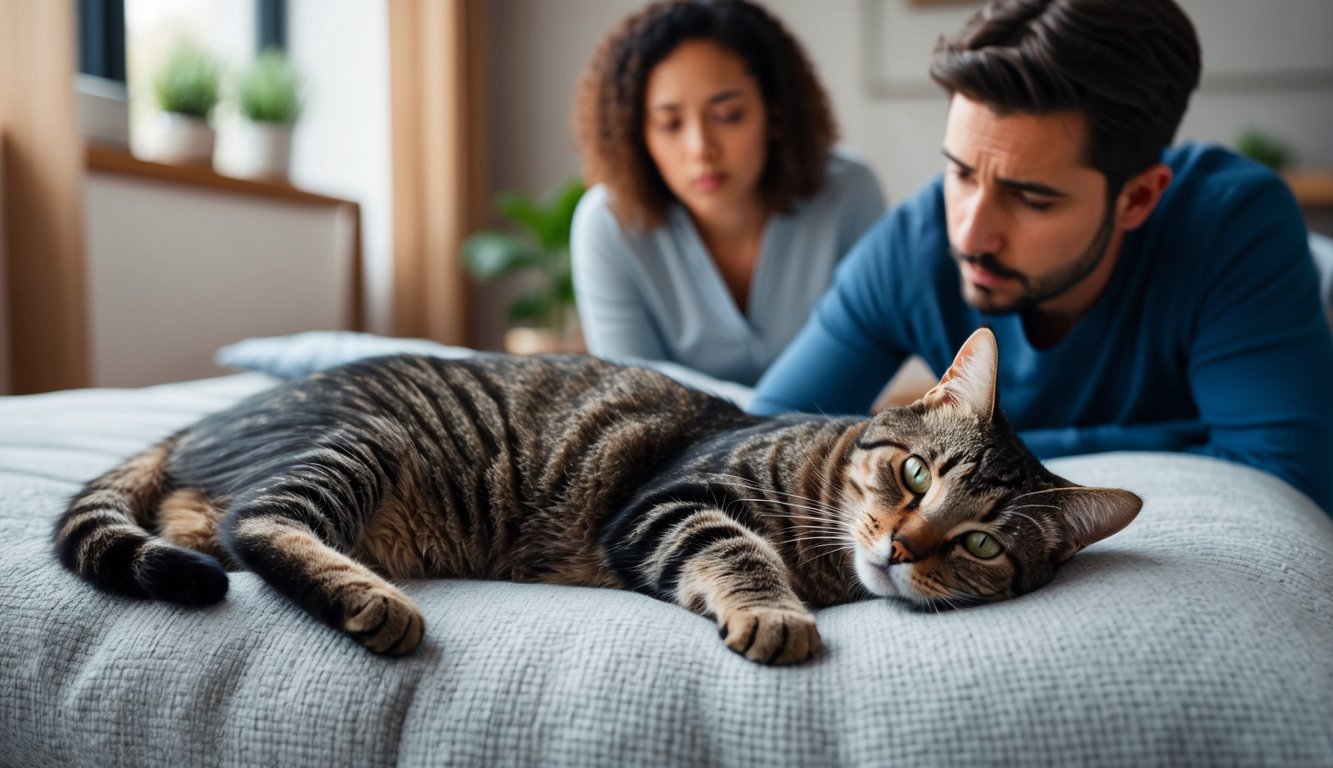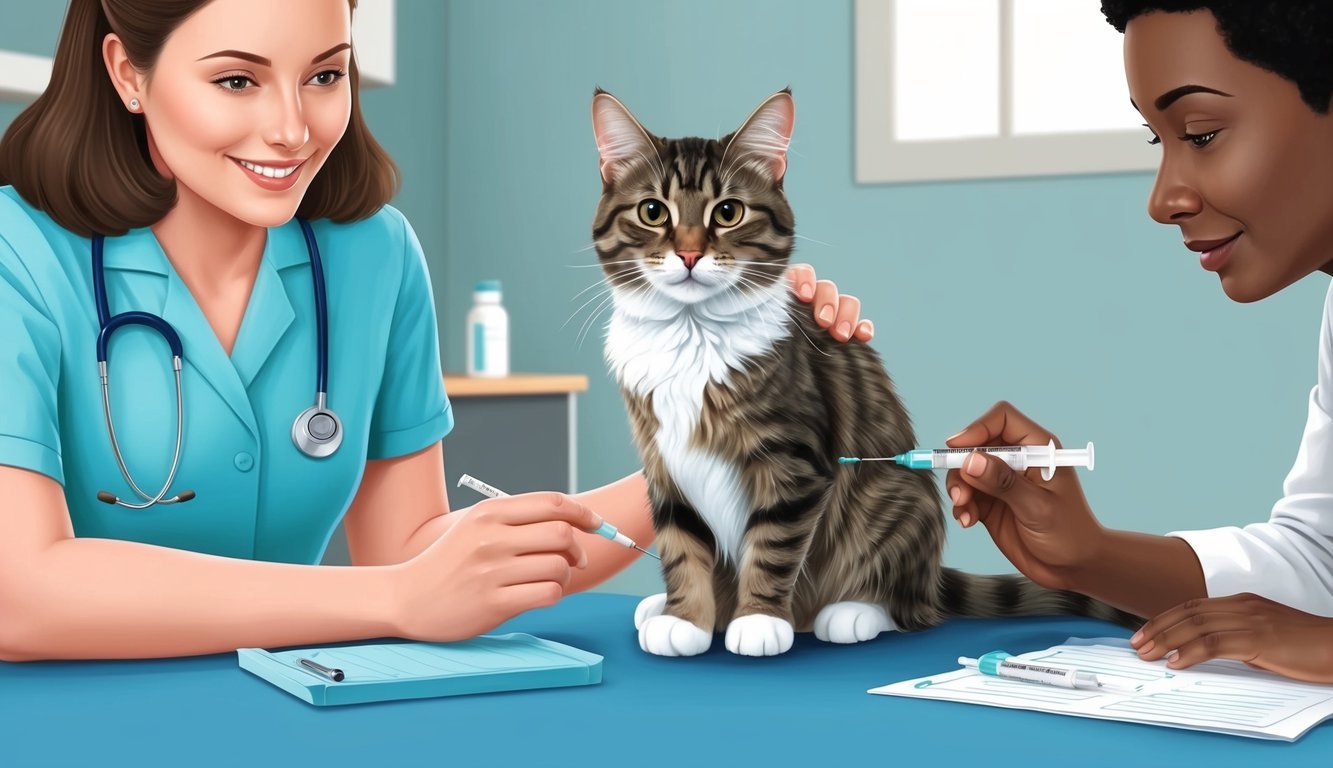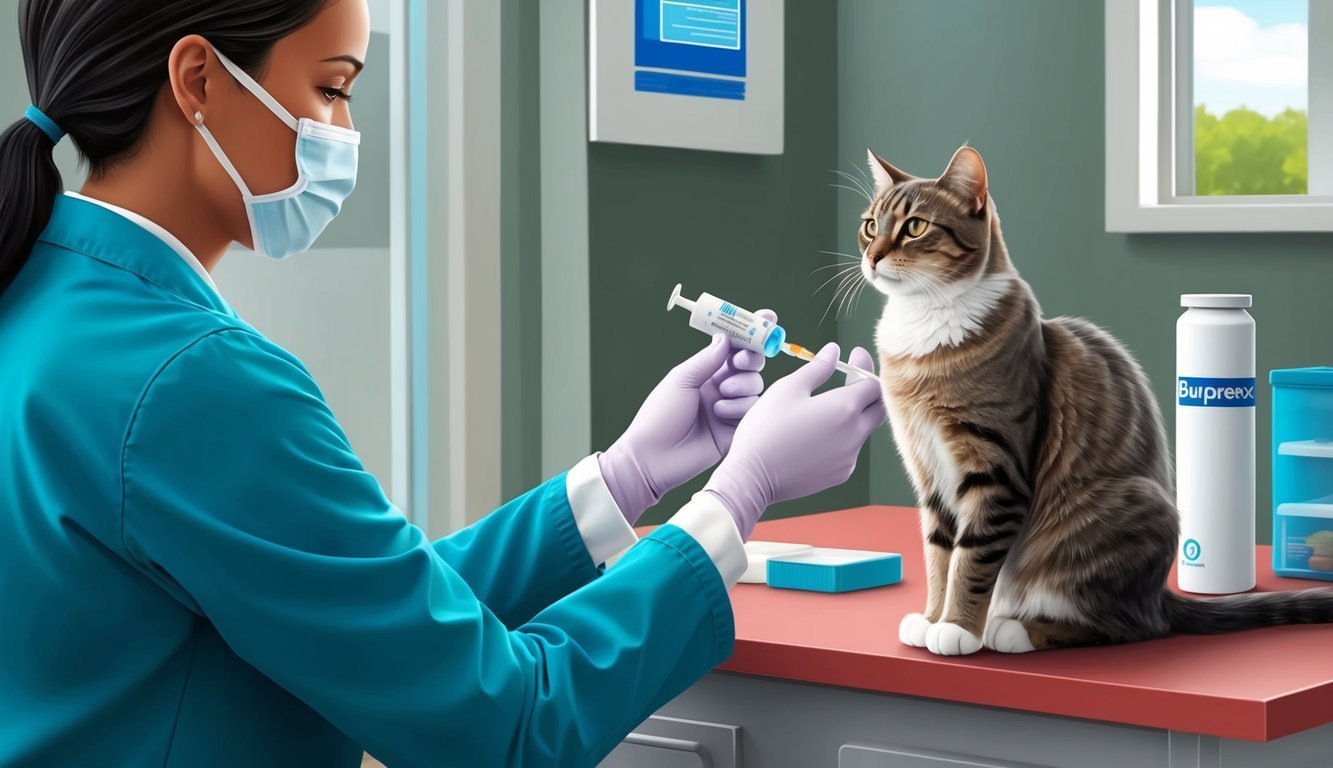Buprenex is a powerful medication that veterinarians often prescribe for cats with moderate to severe pain.
It provides effective relief for various conditions, including post-surgical recovery and injuries.
As a cat owner, knowing how to use Buprenex safely can enhance your pet’s recovery and overall comfort.
Understanding the proper administration and potential side effects of Buprenex is essential for ensuring your cat’s well-being.
Whether you’re new to administering medication or have experience, this guide will walk you through what you need to know about Buprenex, from its usage to its possible risks.
By being informed, you can provide the best care for your cat during their healing process.
The right knowledge not only empowers you but also contributes significantly to your pet’s comfort and health.
Key Takeaways
- Buprenex is effective for managing moderate to severe pain in cats.
- Proper administration and awareness of side effects are crucial for safe use.
- Understanding Buprenex helps enhance your cat’s recovery experience.
What Is Buprenex?
Buprenex, containing the active ingredient buprenorphine, is an essential pain relief medication primarily used in cats.
It is particularly valuable in veterinary medicine for managing mild to moderate pain.
Understanding Buprenorphine
Buprenorphine is a semi-synthetic opioid, recognized for its effectiveness as a pain reliever.
Unlike many other opioids, it is classified as a partial mu-opioid agonist.
This means it activates the opioid receptors in the brain but to a lesser degree.
This unique property helps mitigate pain while reducing the risk of severe side effects and dependency.
In cats, buprenorphine can alleviate postoperative pain and discomfort from various medical conditions.
The drug can be administered via injection or oral formulations, depending on the situation.
It is essential to follow the veterinarian’s guidance to ensure a safe dosage tailored to your cat’s specific needs.
Opioids in Veterinary Medicine
Opioids play a significant role in veterinary medicine, particularly for pain management.
They can ease suffering in animals recovering from surgery or dealing with chronic pain due to health issues.
Buprenorphine is favored for its dual benefits: effective pain relief with a lower risk of addiction compared to stronger opioids.
Veterinarians often rely on this medication to achieve a balance between managing pain and minimizing potential adverse reactions.
Common side effects may include sedation, nausea, and, occasionally, changes in behavior.
As a pet owner, it’s essential to monitor your cat’s response to the medication and report any concerns to your veterinarian.
Buprenex as a Controlled Substance
As with many opioids, buprenex is classified as a controlled substance.
This classification is due to the potential for misuse and dependency.
Regulations vary by region, but typically, there are strict guidelines regarding the prescription and administration of such medications.
When your veterinarian prescribes buprenex, it’s crucial to adhere to the dosage and instructions provided.
Proper management ensures that your cat receives the needed pain relief while reducing any risks associated with opioid use.
Because it’s a controlled substance, it’s essential to store buprenex securely, away from other pets or children.
Always consult your veterinarian if you have concerns about the usage or effects of this medication on your cat.
Using Buprenex for Cats
Buprenex, a formulation of buprenorphine, serves as an important tool for managing pain in feline patients.
Understanding its application, usage guidelines, and considerations regarding FDA approval can enhance your experience in caring for your cat.
Pain Relief for Feline Patients
Buprenex is widely recognized for its effectiveness in providing pain relief for cats.
It’s a semi-synthetic opioid that targets both acute and chronic pain.
Common Uses:
- Post-surgical pain management
- Treatment of injury-related pain
You’ll find that buprenorphine allows your cat to experience relief without heavy sedation.
It works by binding to specific receptors in the brain, effectively blocking pain signals.
Chronic Pain and Surgical Procedures
Using Buprenex can be particularly beneficial for cats experiencing chronic pain or recovering from surgery.
It offers a reliable option for ongoing pain management.
For surgical procedures, veterinarians often recommend buprenorphine to ease discomfort from incisions or tissue injuries.
Buprenex allows for smoother recovery, enabling your cat to regain normal activity levels sooner.
Chronic Pain Considerations:
- Long-term use is generally safe but should be monitored by a veterinarian.
- Behavioral changes may occur, such as increased purring or changes in activity levels.
Dosage and Administration Guidelines
Administering Buprenex must be done cautiously.
Dosage varies based on individual cat needs, weight, and the severity of pain.
General Guidelines:
- Typical doses range from 0.01 to 0.05 mg/kg.
- Administer every 6 to 12 hours as directed by your veterinarian.
You should always follow your vet’s instructions closely.
If you notice any side effects—like excessive sleepiness or dilated pupils—notify your veterinarian promptly to adjust the dosage.
Off-Label Use and FDA Approval
Although buprenorphine is FDA-approved for human use, its application in veterinary medicine falls under off-label use.
This means that vets can prescribe it for cats due to its effectiveness, despite lacking explicit FDA approval for this specific use.
Important Points:
- Off-label use is common in veterinary medicine and often beneficial.
- Your veterinarian should weigh the pros and cons based on your cat’s health status.
This practice allows for greater flexibility in managing pain, although it’s essential to have proper oversight from your veterinarian to ensure safety and efficacy.
Proper Administration
Administering Buprenex to your cat requires careful attention to detail.
Understanding the best methods for delivery and how to monitor your cat’s response can help ensure effective pain management with minimal side effects.
Transmucosal Delivery
The oral transmucosal route is a popular method for administering Buprenex.
This involves placing the medication between your cat’s gums and cheek, allowing it to absorb directly into the bloodstream.
Steps for Transmucosal Delivery:
- Prepare the Medication: Ensure the Buprenex is at room temperature for better absorption.
- Position Your Cat: Gently hold your cat, using a towel if necessary to prevent movement.
- Administer the Dose: Use a syringe to place the medication in the buccal cavity, avoiding the tongue.
This method can be less stressful for both you and your pet.
Cats typically tolerate it well, and it provides effective pain relief without the need for injections.
Other Delivery Methods
While transmucosal delivery is effective, other methods are available depending on your cat’s needs.
- Subcutaneous Injection: This involves injecting Buprenex under the skin. It’s often used for quicker action, especially in severe pain scenarios.
- Transdermal Patches: These are less common for Buprenex but can be beneficial in some cases. They allow for continuous absorption through the skin.
Always ensure you are following your veterinarian’s instructions for any method.
This will help you achieve the desired pain relief while minimizing risks.
Monitoring Compliance
Monitoring your cat after administering Buprenex is crucial.
Observe for any signs of discomfort or adverse reactions.
Common side effects include sedation, dilated pupils, or changes in behavior.
Key Points for Monitoring:
- Check Vital Signs: Look for any changes in breathing or heart rate.
- Behavioral Changes: Note significant changes, such as increased purring or hiding.
- Follow-up: Schedule regular vet visits to assess the effectiveness of the treatment and adjust dosages if needed.
Being attentive to these details helps ensure your cat receives the best possible care while on Buprenex.
Side Effects and Complications

When using Buprenex for your cat, it’s important to be aware of potential side effects and complications.
These can range from mild reactions to serious concerns that may require immediate attention.
Understanding these aspects can help you ensure your feline friend remains safe and comfortable.
Common Adverse Reactions
Buprenex may cause several common side effects in cats.
Sedation is one frequently observed reaction, where your cat might appear sleepy or less active than usual.
This effect can be beneficial as it often indicates pain relief, but it may also raise concerns for pet owners.
Mydriasis, or dilated pupils, is another typical side effect.
You might notice your cat’s pupils appearing larger than normal.
Some cats also exhibit increased purring or more affectionate behavior.
While these reactions are generally manageable, keep an eye out for any unusual behavior.
If you notice significant changes or prolonged effects, consult your veterinarian for guidance.
Managing Overdose and Respiratory Depression
Overdose is a serious concern with any medication, including Buprenex.
Although rare, an overdose can lead to significant complications.
Symptoms of overdose may include deep sedation, difficulty breathing, or even loss of consciousness.
Respiratory depression is another serious complication.
If your cat appears to be struggling to breathe or shows altered breathing patterns, immediate veterinary assistance is crucial.
To manage overdose risks, follow the prescribed dosage closely.
If you suspect an overdose, act quickly and contact your veterinarian.
Quick intervention can make a significant difference in your cat’s recovery.
Vomiting and Sedation Concerns
Vomiting can occur as a side effect of Buprenex, and it may be concerning for you as a pet owner.
While occasional mild vomiting can happen, persistent vomiting is a reason to seek veterinary advice.
Keeping track of your cat’s health after medication administration can help in identifying any issues early.
Sedation is another concern connected to Buprenex use.
While sedation is often a desired effect for pain relief, excessive drowsiness is something to monitor closely.
If your cat seems overly sedated or unresponsive, it’s important to consult with your veterinarian immediately.
Recognizing and addressing these potential side effects will help ensure your cat remains safe and comfortable during their treatment.
Potential for Misuse and Alternatives

While buprenex can be effective for managing pain in cats, it does carry risks of misuse, especially in households with multiple pets.
Understanding these risks and exploring alternative pain management options is essential for responsible pet ownership.
Preventing Misuse in Multi-Pet Households
In homes with several animals, the potential for misuse of buprenex increases.
To safeguard against this, you should store all medications in a secure place, ideally a cabinet out of reach of pets.
Label all medications clearly and maintain a log of dosages administered to each pet.
This ensures consistency and prevents accidental overdoses.
If you’re also treating dogs or other animals, be mindful of their reactions to opioid medications.
Always consult your veterinarian about any signs of discomfort in your pets and have naloxone available as a precaution for an opioid overdose.
Alternatives for Pain Management
If buprenex isn’t suitable for your pet, several alternatives exist for managing pain.
Non-steroidal anti-inflammatory drugs (NSAIDs), like carprofen, are commonly used and can be effective for various conditions.
Consider physical therapies, acupuncture, or other holistic approaches that can provide relief without medication.
Each alternative may suit different pets depending on their specific health conditions.
Always consult your veterinarian to tailor a pain management plan that’s safe and effective.
Tools like animal poison control hotlines can also be vital resources for emergencies related to medication mismanagement.
Veterinary Care and Owner Responsibilities

Caring for a cat on buprenex involves important responsibilities for both you and your veterinary team.
It’s essential to follow guidelines that ensure your pet’s safety and well-being while managing their pain effectively.
Importance of Veterinary Guidance
Consulting with your veterinarian before administering buprenex is crucial.
They will assess your cat’s condition and determine if this medication is suitable for their pain management needs.
Your vet will provide guidance on dosage, administration methods, and the frequency of use.
Regular check-ups are essential to monitor your cat’s response to the medication and make necessary adjustments.
This oversight helps avoid potential problems and ensure your pet receives effective care tailored to their specific needs.
Communication with Vet Professionals
Open lines of communication with your veterinary team enhance treatment outcomes.
Always discuss any changes you observe in your cat’s behavior or health after starting buprenex.
Provide details about your cat’s diet, any other medications, and any health conditions.
If you notice side effects such as excessive sedation or unstable behavior, inform your vet immediately.
Working together ensures accurate pain management and keeps your cat safe during treatment.
Maintaining Medication Records
Keeping thorough medication records is a smart practice.
Document when you administer buprenex, the dosage, and any observations related to your cat’s health.
Use a simple chart or a digital document to track this information.
This record helps your vet see patterns or side effects over time, which can be instrumental when adjusting dosages or methods.
Proper record-keeping also ensures you won’t miss a dose, maintaining the effectiveness of the treatment.
Medication Storage and Safety
Proper storage of buprenex is essential to maintain its efficacy.
Always keep the medication in its original container, tightly sealed, and in a cool, dry place away from direct sunlight.
Make sure to store it out of reach of pets and small children.
Be aware of the expiration date, and dispose of any expired medication responsibly.
If your cat experiences concerning side effects, refer to your vet immediately for guidance on how to proceed.
Conclusion

When it comes to managing pain in your cat, Buprenex can be an effective option in veterinary medicine.
It’s important to note that this medication is commonly used for short-term pain relief.
One of the most noticeable effects you might see is sedation.
This is normal and indicates that the medication is working to alleviate your cat’s discomfort.
You should be aware of potential side effects.
These may include:
- Dilated pupils
- Increased purring or rubbing behavior
- Temporary changes in activity level
Always consult with your veterinarian to ensure proper usage and dosing.
They can provide tailored advice on how best to administer Buprenex to your furry friend.
While Buprenex serves an important role in pain management, monitoring your cat after administration is essential.
Keeping track of any changes can help your vet gauge how well it’s working.
Frequently Asked Questions
When considering Buprenex for your cat, you might have several questions about its effects, dosing, and overall use.
Here’s a straightforward look at these common inquiries.
What are the potential side effects of using Buprenex in cats?
Buprenex can have side effects, with sedation being one of the most common.
You might notice your cat being sleepier than usual.
Other potential side effects can include vomiting or respiratory depression, although these are less frequent.
How should Buprenex be dosed and administered to cats?
Dosing Buprenex typically depends on your cat’s weight and specific condition.
It’s available as an injectable or oral solution.
Always follow your veterinarian’s instructions for the correct dosage and method of administration.
How long does the pain relief from Buprenex last in felines?
The duration of pain relief from Buprenex generally ranges from 6 to 12 hours.
This can vary based on the method of administration and your cat’s individual response to the medication.
Can Buprenex cause a lack of appetite in cats?
Yes, some cats may experience a decrease in appetite while on Buprenex.
If you notice your cat eating less, it’s a good idea to consult your veterinarian for advice.
What is the onset time for pain relief when using buprenorphine in cats?
The onset of pain relief can vary, but you can typically expect it to start within 30 minutes to an hour after administration.
This timing may depend on how the medication is given to your cat.
How does Buprenex compare with morphine in terms of strength for feline pain?
Buprenex is considered to be a potent analgesic, though it is not as strong as morphine.
It is often preferred for its safety profile and lower risk of side effects, making it a suitable option for managing pain in cats.


